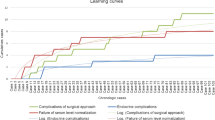Abstract
To analyze the clinical presentation, management and outcomes of patients with pituitary adenoma treated by Endoscopic Endo-nasal Trans-sphenoidal (EETS) excision. Study was conducted on the basis of medical records of 14 patients who had undergone EETS excision of pituitary adenomas. The data obtained was assessed for demographic and clinical characteristics, radiographic features and post-operative outcomes. Study included 10 males and 4 females. Mean age of patients was 46.43 years (range 16–70 Years). Most common presentation was diminished vision reported in 79% patients. Features of acromegaly encountered in 21% cases. Location of majority of tumors was sellar with supra-sellar extension (71%) followed by sellar (14%), sellar with para-sellar extension (7%) and sellar with supra-sellar and para-sellar extensions (7%). Total tumor resection was achieved in 64% cases and sub-total resection in 36% cases. One of the lesions on biopsy revealed granulomatous pathology. No post-operative complication was seen in 71% patients. Transient Diabetes Insipidus was observed in 21% cases that resolved within 3–4 days. One patient expired due to meningitis and septicemia. One patient had CSF leak that was effectively managed by placing lumbar drain. There was significant improvement in visual symptoms and hormonal levels. Average hospital stay was 13.54 days and mean follow up period was 13 months. EETS approach is safe, minimally invasive and effective surgical technique for resection of pituitary adenomas with low post-operative morbidity, reduced hospital stay and better remission of symptoms.
Similar content being viewed by others
References
Cappabiansa P, Cavallo LM, de Divitis E (2004) Endoscopic endo-nasal trans-sphenoidal surgery for pituitary. Neurosurgery 55:933–941
Griffith HB, Veerapen R (1987) A direct trans-nasal approach to the sphenoid sinus. Technical note. J Neurosurg 66:140–142
Jho HD, Carrau RI (1997) Endoscopic endo-nasal trans-sphenoidal surgery: experience with 50 patients. J Neurosurg 87:44–51
Chone CT, Sampaio MH, Sakano E, Paschoal JR, Garnes HM, Queiroz L et al (2014) Endoscopic endo-nasal trans-sphenoidal resection of pituitary adenomas: preliminary evaluation of consecutive cases. Braz J Otorhinolaryngol 80:146–151
Van Lindert EJ, Ingels K, Mylanus E, Grotenhuis JA (2010) Variations of endo-nasal anatomy: relevance for the endoscopic endo-nasal trans-sphenoidal approach. Acta Neurochir 152(6):1015–1020
Nie S, Li K, Huang Y, Zhao J, Gao X, Jie S (2015) Endoscopic endo-nasal trans-sphenoidal surgery for treating pituitary adenoma via a sub-septum mucosa approach. Int J Clin Exp Med 8(4):5137–5143
Boxerman JL, Rogg JM, DonahueJE Machen JT, Goldman MA, Doberstein CE (2010) Preoperative MRI evaluation of pituitary macroadenoma: imaging features predictive of successful transsphenoidal surgery. Am J Roentgenol 195(3):720–728
Hsu C-P, Chang C-K, Chiang M-F, Tsai C-C, Chen S-J (2016) Endoscopic endo-nasal trans-sphenoidal approach for pituitary fossa tumor: outcome analysis of 39 consecutive procedures. J Cancer Res Pract 3(2):39–44
Varshney S, Gupta C, Bansal KK, Bist SS, Bhagat S (2013) Endoscopic trans-nasal trans-sphenoidal (TNTS) approach for pituitary adenomas: our experience. Indian J Otolaryngol Head Neck Surg 65(2):S308–S313
Yadav YR, Sachdev S, Parihar V, Namdev H, Bhatele PR (2012) Endoscopic endo-nasal trans-sphenoid surgery of pituitary adenoma. J Neorosci Rural Pract 3(3):328–337
Zada G, Daniel FK, Pejman C, Christina W, Ronald S (2003) Endonasaltranssphenoidal approach to treat pituitary adenomas and other sellar lesions: an assessment of efficacy, safety and patient impressions of surgery. J Neurosurg 98(2):350–358
Choe Jai-Ho, Kun-Soo L, Sin-Soo J, Jin-Hee C, Yong-Kil H (2008) Endocrine outcome of endoscopic endo-nasal trans-sphenoidal surgery in functioning pituitary adenomas. J Korean Neurosurg Soc 44(3):151–155
Jankowski R, Auque J, Simon C, Marchal JC, Hepner H, Wayoff M (1992) Endoscopic pituitary tumor surgery. Laryngoscope 102:198–202
Kiboi JG, Kitunguu PK, Musau CK, Mwangombe NJ (2012) Clinical experience and outcome of pituitary surgery in Kenyan patients at the Kenyatta National Hospital: case report/case clinique. Afr J Neurol Sci 31(2):49–60
Zhan R, Guangming X, Wiebe TM, Xingang L (2015) Surgical outcomes of the endoscopic tanssphenoidal route to pituitary tumors in pediatric patients >10 years of age: 5 years of experience at a single institute. (Available at Arch Dis Child doi: 10.1138/archdischild-2015-308365)
Author information
Authors and Affiliations
Corresponding author
Ethics declarations
Conflict of interest
The authors declared that they have no conflicts of interest.
Rights and permissions
About this article
Cite this article
Singh, A., Grewal, S.S. & Kumar, N. Endoscopic Endo-Nasal Trans-Sphenoidal Excision of Pituitary Tumors: An Institutional Experience. Indian J Otolaryngol Head Neck Surg 70, 98–101 (2018). https://doi.org/10.1007/s12070-017-1194-2
Received:
Accepted:
Published:
Issue Date:
DOI: https://doi.org/10.1007/s12070-017-1194-2




